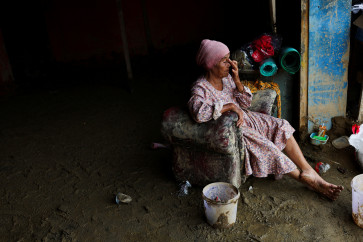Popular Reads
Top Results
Can't find what you're looking for?
View all search resultsPopular Reads
Top Results
Can't find what you're looking for?
View all search resultsBraga: past and present
A large banner displaying pictures of olden and present-day Jl
Change text size
Gift Premium Articles
to Anyone
A large banner displaying pictures of olden and present-day Jl. Braga towers over the entrance of Braga City Walk shopping center.
Street art: Various paintings are also on the offer on Jl. Braga.
But only a few people notice the pictures, perhaps because they are less appealing to most visitors.
They seem to be more interested in the piles of clothes sold at half price and menus offered by cafes and restaurants in the shopping complex.
From the Dutch colonial period to the 1980s, Bragaweg or Jl. Braga used to be the most famous street in the city of Bandung, West Java.
From 1830 to 1870, the 600-meter road was known as Pedatiweg (Jl. Pedati or horse cart road). As the name suggests, the road was meant for horse carts carrying coffee from the coffee warehouse (koffie pakhuis), which is now the City Hall.
So, where does the name Jl. Braga originate from? Some say it came from a Dutch drama troupe and one of its playwrights Theotilo Braga. Others believe the street inherited its name from a god of poetry in German mythology called Bragi.
According to a Sundanese man of letters, Baraga was named after the Sundanese word ngabaraga (going by the riverside), and refers to riverbank road. Jl. Braga is indeed located by Cikapundung River.
Over the years, the small road of Jl. Pedati mushroomed into a busy area. Dutch businessmen built shops, bars and entertainment places there. Meeting halls, French styled boutiques and Art Deco buildings followed, adding fame to Bragaweg and transforming it into an affluent area.
The road later became famous across the Dutch East Indies and even overseas. But no one really knows when the street started to be called Braga instead of Pedati. Nowadays, the street still exudes the beauty of a 19th century town, having retained some of its old buildings.
Memorable: Bragaweg or Jl. Braga was once the most famous street in Bandung.
The road, once designed for pedestrians only, is now covered with andesite rather than asphalt, and at the mercy of road traffic.
Bandung city administration may one day be able to follow in the footsteps of Jakarta’s provincial administration, which prohibits motor vehicles from entering several old parts of Jakarta.
But with the growth of Bandung, local tourists may now be more familiar with Jl. Cihampelas, Dago and Riau, than with the historical part of town, once known as the Paris of Java. Local tourists, particularly those from Jakarta, are drawn to different areas of town like Cihampelas, Dago and Riau, and their factory outlets.
On weekends, the three zones are teeming with tourists and shoppers from morning to late at night, unlike Jl. Braga in the daytime, which is less lively because some of its restaurants, cafes and amusement places only open in the evening, with sidewalk vendors selling paintings before sunset.
Braga, the road once so famous for its architecture and selection of goods well above the level of other shopping areas, is now lagging behind with the emergence of diverse commercial centers in all parts of Bandung.
Old and new: Classic building still stand tall along the famous Jl. Braga in Bandung.
— Photos by Arief Suhardiman












